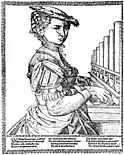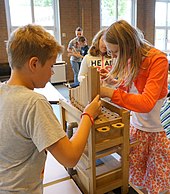27:
243:
258:
135:
147:
224:
418:
322:). Still larger positives may have a 4 ft principal or a second 8 ft stop, the latter often treble-only. More complex examples feature a divided keyboard, which allows each stop to be activated separately in the treble and bass portions of the keyboard. This makes it possible to play a melody and an accompaniment simultaneously on different registrations. Most positives have just one manual keyboard and no
26:
208:
Many positives, both of the box and 'cupboard' types, can be divided into upper and lower parts to be more easily moved. The lower part then usually contains the bellows, blower and/or treadle, and perhaps a few of the largest pipes. Wheels,
186:
periods, positive organs were used at many kinds of civil and religious functions. They were used in the homes and chapels of the rich, at banquets and court events, in choirs and music schools, and in the small orchestras of
362:
However, since the
Orgelbewegung revival of small organs, small positives to be played with both hands have also come to be called 'portatives' in many cases, especially when their pipes are arranged without housing in a
350:
in that it is larger and is not played while strapped at a right angle to the performer's body. It also has a larger keyboard (typically 49 notes or more in modern examples, often 45 or so notes with a
117:
the instrument came in many different forms, including processional and tabletop organs that have profited relatively less from the renewed popularity the type in general has enjoyed from the
512:
31:
242:
375:
The
Positive is also a traditional department of a large organ, often placed behind the organist's back and more or less the size of a separate positive organ. In
86:
that is built to be more or less mobile. It was common in sacred and secular music between the 10th and the 18th centuries, in chapels and small churches, as a
34:), Japan, 2011, with portative-like pipe and bellows arrangement. On the portative, however, the bellows were operated directly by one of the player's hands.
257:
433:
470:
171:
representing interesting varieties of the portable organ of the Middle Ages, including Add. MS. 29902 (fol. 6), Add. MS. 27695b (fol. 13), and
223:
491:
438:
519:
326:, but there are examples with a set of pedal pulldowns or even a pedal stop or two, as well as rarer ones with two manuals.
838:
168:
355:
in older ones), while a portative may have as few as 12 or 13 notes. The positive is also not to be confused with the
102:
and is especially popular nowadays for basso continuo work; positives for more independent use tend to be higher.
338:
in order to supply wind to the instrument, but most modern positives include electric blowers for this purpose.
833:
175:
A VII. fol. 104d., all of the 14th century, and Add. MS. 28962 and Add. MS. 17280, both of the 15th century.
549:
230:
356:
319:
94:
in ensemble works. The smallest common kind of positive, hardly higher than the keyboard, is called
782:
675:
609:
604:
843:
714:
644:
364:
159:
A well-known instance of an early positive or portable organ of the 4th century occurs on the
392:
160:
134:
118:
777:
724:
709:
684:
649:
505:
334:
Before electricity, positives required either the player or a second person to operate the
87:
8:
772:
729:
699:
532:
172:
485:
264:
689:
614:
192:
661:
146:
797:
767:
579:
559:
388:
292:
and 2 ft principal (diapason) is common. Somewhat larger positives may also have a
282:
75:
289:
217:
are other aids to mobility, which have become vastly more common in modern times.
19:"Box organ" redirects here. For the portable organ also called a "box organ", see
787:
574:
396:
347:
311:
734:
596:
569:
564:
541:
459:
323:
164:
91:
827:
807:
554:
429:
424:
307:
757:
694:
352:
20:
812:
802:
762:
744:
188:
179:
110:
106:
739:
671:
634:
626:
528:
278:
214:
83:
488:
available for sale or rent by New
England Organbuilders of Connecticut
719:
656:
639:
591:
586:
497:
359:, a small keyboard instrument that contains short-length reed pipes.
315:
249:
458:(2007). Encyclopædia Britannica Online, accessed December 23, 2007.
423:
This article incorporates text from a publication now in the
704:
376:
335:
285:
183:
163:
on his death in AD 395. Among the illuminated manuscripts of the
114:
281:
due to their small size and portable nature; a specification of
234:
210:
248:
Children in primary school are assembling a do-organ of
30:
Laukhuff positive organ in
Yokohama Minato Mirai Hall (
825:
152:Positive organ, from a German print, circa 1575.
492:Picture of a seventeenth century positive organ
140:Organ from the Utrecht Psalter, circa 850 a.d.
82:, "to place") is a small, usually one-manual,
513:
161:obelisk erected to the memory of Theodosius I
442:(11th ed.). Cambridge University Press.
195:at the dawn of the musical drama or opera.
520:
506:
370:
469:One example of a two-manual positive at
428:
391:and many modern organs. Also, since the
25:
826:
527:
341:
277:Positive organs typically exhibit few
501:
486:Picture of a new 2009 positive organ
346:The positive organ differs from the
494:at the Vienna Museum of Art History
367:row like in the genuine portative.
13:
14:
855:
479:
407:) can be encountered in English.
383:, later to be corrupted into the
263:Chest, or box, organ used during
416:
256:
241:
222:
145:
133:
198:
463:
448:
329:
1:
410:
472:, accessed October 19, 2010.
7:
231:Karlskrona Admiralty Church
10:
860:
124:
18:
839:Early musical instruments
753:
670:
625:
540:
203:
314:, and some have an 8 ft
272:
456:Encyclopædia Britannica
439:Encyclopædia Britannica
371:Other uses of the term
35:
379:it became known as a
29:
834:Keyboard instruments
730:Trompette militaire
601:Combination action
342:Compass and various
173:Cotton MS. Tiberius
783:Historical Society
454:"Positive organ."
387:division found on
229:Positive organ in
193:Claudio Monteverdi
36:
821:
820:
610:Tubular-pneumatic
605:Electro-pneumatic
213:or a custom-made
851:
580:Expression pedal
560:Eight-foot pitch
522:
515:
508:
499:
498:
473:
467:
461:
452:
443:
422:
420:
419:
305:
304:
300:
297:
265:La Folle Journée
260:
245:
226:
149:
137:
16:Small pipe organ
859:
858:
854:
853:
852:
850:
849:
848:
824:
823:
822:
817:
749:
666:
621:
575:Crescendo pedal
536:
526:
482:
477:
476:
468:
464:
453:
449:
432:, ed. (1911). "
417:
415:
413:
373:
348:portative organ
344:
332:
310:and/or a small
302:
298:
295:
293:
288:(capped), 4 ft
275:
268:
261:
252:
246:
237:
227:
206:
201:
167:there are many
157:
156:
155:
154:
153:
150:
142:
141:
138:
127:
24:
17:
12:
11:
5:
857:
847:
846:
844:Organs (music)
841:
836:
819:
818:
816:
815:
810:
805:
800:
795:
790:
785:
780:
775:
770:
765:
760:
754:
751:
750:
748:
747:
742:
737:
732:
727:
722:
717:
712:
707:
702:
697:
692:
687:
681:
679:
668:
667:
665:
664:
659:
654:
653:
652:
647:
637:
631:
629:
623:
622:
620:
619:
618:
617:
612:
607:
599:
594:
589:
584:
583:
582:
577:
567:
562:
557:
552:
546:
544:
538:
537:
525:
524:
517:
510:
502:
496:
495:
489:
481:
480:External links
478:
475:
474:
462:
446:
445:
434:Positive organ
430:Chisholm, Hugh
412:
409:
372:
369:
343:
340:
331:
328:
274:
271:
270:
269:
262:
255:
253:
247:
240:
238:
228:
221:
205:
202:
200:
197:
165:British Museum
151:
144:
143:
139:
132:
131:
130:
129:
128:
126:
123:
92:basso continuo
52:portable organ
40:positive organ
15:
9:
6:
4:
3:
2:
856:
845:
842:
840:
837:
835:
832:
831:
829:
814:
811:
809:
806:
804:
801:
799:
796:
794:
791:
789:
786:
784:
781:
779:
776:
774:
771:
769:
766:
764:
761:
759:
756:
755:
752:
746:
743:
741:
738:
736:
733:
731:
728:
726:
723:
721:
718:
716:
713:
711:
708:
706:
703:
701:
698:
696:
693:
691:
688:
686:
683:
682:
680:
677:
673:
669:
663:
660:
658:
655:
651:
648:
646:
643:
642:
641:
638:
636:
633:
632:
630:
628:
624:
616:
613:
611:
608:
606:
603:
602:
600:
598:
595:
593:
590:
588:
585:
581:
578:
576:
573:
572:
571:
568:
566:
563:
561:
558:
556:
553:
551:
548:
547:
545:
543:
539:
534:
530:
523:
518:
516:
511:
509:
504:
503:
500:
493:
490:
487:
484:
483:
471:
466:
460:
457:
451:
447:
444:
441:
440:
435:
431:
426:
425:public domain
408:
406:
402:
398:
394:
393:Orgelbewegung
390:
386:
382:
378:
368:
366:
360:
358:
354:
349:
339:
337:
327:
325:
321:
317:
313:
309:
308:mutation stop
291:
287:
284:
280:
266:
259:
254:
251:
244:
239:
236:
232:
225:
220:
219:
218:
216:
212:
196:
194:
190:
185:
181:
176:
174:
170:
166:
162:
148:
136:
122:
120:
119:Orgelbewegung
116:
112:
108:
103:
101:
97:
93:
89:
88:chamber organ
85:
81:
77:
73:
69:
65:
61:
57:
53:
49:
48:positif organ
45:
44:positiv organ
41:
33:
28:
22:
792:
735:Voix céleste
725:Registration
695:Tibia Clausa
542:Construction
465:
455:
450:
437:
414:
404:
400:
384:
380:
374:
361:
353:short octave
345:
333:
306:ft or other
276:
207:
199:Construction
177:
158:
104:
99:
95:
90:and for the
79:
74:) (from the
71:
67:
63:
59:
58:, or simply
55:
51:
47:
43:
39:
37:
21:Barrel organ
745:Zimbelstern
529:Pipe organs
405:Rückpositiv
401:Ruckpositiv
381:Chair organ
330:Wind supply
318:(such as a
189:Jacopo Peri
180:Renaissance
111:Renaissance
107:Middle Ages
56:chair organ
828:Categories
798:Repertoire
768:Fairground
740:Vox humana
715:Ophicleide
635:En chamade
411:References
215:hand truck
169:miniatures
84:pipe organ
788:Portative
720:Plein-jeu
592:Swell box
587:Tremulant
365:chromatic
316:reed stop
250:Orgelkids
121:onwards.
105:From the
100:box organ
793:Positive
550:Builders
389:Romantic
109:through
60:positive
808:Theatre
710:Mixture
705:Gedackt
685:Bourdon
650:Voicing
645:Scaling
597:Tracker
555:Console
427::
377:England
336:bellows
312:mixture
301:⁄
286:Gedackt
211:casters
184:Baroque
178:In the
125:History
115:Baroque
68:positif
64:positiv
778:German
773:French
758:Barrel
700:Cornet
662:Tuning
570:Pedals
565:Manual
421:
397:German
395:, the
324:pedals
267:, 2009
235:Sweden
204:Casing
80:ponere
42:(also
813:Water
803:Shoes
763:Crawl
690:Tibia
672:Stops
627:Pipes
399:term
385:Choir
357:regal
320:regal
290:flute
279:stops
273:Stops
96:chest
78:verb
76:Latin
72:chair
70:, or
676:List
657:Reed
640:Flue
615:Stop
533:list
283:8 ft
191:and
182:and
113:and
436:".
98:or
830::
233:,
66:,
62:,
54:,
50:,
46:,
38:A
32:ja
678:)
674:(
535:)
531:(
521:e
514:t
507:v
403:(
303:3
299:2
296:+
294:2
23:.
Text is available under the Creative Commons Attribution-ShareAlike License. Additional terms may apply.





